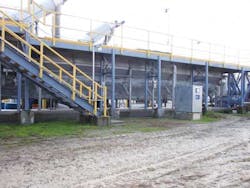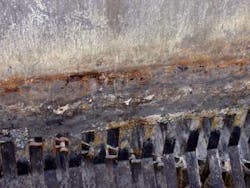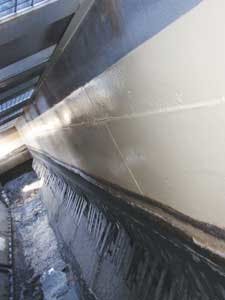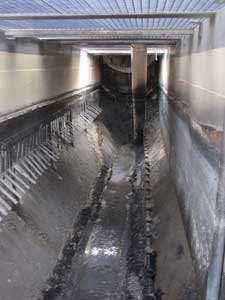Resisting Corrosion: Water Authority Protects Stainless Steel Structure from Future Degradation
By Jon C. Lattin and John E. Davis
For municipalities and municipal utility authorities struggling to deal with corrosion issues, knowing where to turn when faced with these challenges can be daunting. Logan Township Municipal Utilities Authority (MUA) of New Jersey was faced with such problems when a five-year-old stainless steel headworks tank at its wastewater treatment facility was experiencing extreme Microbiological Induced Corrosion (MIC) at the waterline with corrosion severe enough to open holes through the tank wall. The 304 stainless steel tank was no longer covered by the tank manufacturer's warranty, and the manufacturer didn't offer any satisfactory solutions to rectify the corrosion issues.
The problem became even more complicated for MUA when a selected lining system was discontinued by the coatings manufacturer just one week prior to installation. Unsure of where to go next, it contacted Corrosion Technology Systems Inc., a manufacturer's representative for Sauereisen Inc. of Pittsburgh, Pa. MUA needed help identifying an engineered solution, finding a quality contractor/applicator and securing on-site support to ensure the project was completed successfully.
Logan Township MUA, located in Gloucester County on the Delaware River, has a population of just over 6,000. A working class community, it boasts a unique mixture of residential, farmland, commercial, industrial, and retail areas within its 23 square miles. While many other MUAs are facing reductions in their infrastructure and repair budgets, Logan Township MUA, through prudent fiscal management and good stewardship of rate payers' dollars, provides its customers with a consistent level of services with predictable cost. MUA discharges only the highest quality effluent back into the Delaware River and has received several awards from the New Jersey Department of Environmental Protection as well as the Environmental Protection Agency (EPA) recognizing its operational excellence.
The wastewater treatment process begins at the headworks structure. A complex network brings raw wastewater into the facility via miles of underground piping from the municipality's collection system and from septage waste delivered by truck. The headworks structure can be concrete or steel and can be located either below-grade or aboveground. Its primary function is to remove debris such as solids, paper, sand and grit, metals, plastic, etc., before sending the influent stream to the equalization tank for distribution to one of MUA's four biological treatment units. It is the first step in the process of reducing the level of pollutants in the wastewater stream.
It was in this first stage of the treatment process that MUA noticed problems that allowed raw wastewater to leach out of the aboveground structure, creating potential health hazards and unsanitary conditions around the stainless steel tank.
Logan Township MUA learned the hard way that not all stainless steel is equal and that the grade and surface finish will determine the ability of the stainless steel to function properly for its intended use. Making the situation worse, the 57-foot-long, 10-foot-deep, and 6-foot-wide tank had several solid stainless steel hatches that trapped H2S within the unit above the waterline.
Testing by MUA was very minimal; however the sulfide tests that were run showed low levels of sulfides. The investigation revealed that the tank was constructed of 304 grade stainless steel, which is not sufficient enough to provide the necessary protection required in this environment. Stainless steel is a corrosion- resistant steel alloy with a minimum of 10.5% chromium content by weight. The most common austenite steel is 304 stainless steel with a composition of 18% chromium and 8% nickel. It is not supposed to corrode or rust like common carbon steel. However, under specific conditions - such as 100% O2 environments or containment with poor circulation, as is the case at Logan Township MUA - 304 stainless steel can corrode. Higher grade stainless, with sufficient chromium, will form a passive film of chrome-oxide on the surface to prevent attack and penetration into the steel substrate below in the form of iron oxide. A higher grade of stainless steel could have prevented this corrosion from occurring.
Aulffo Painting of Minotola, N.J., was consulted for its expertise on tank rehabilitation and to perform the tank refurbishment. "We constantly strive to provide long-lasting service and affordability to our customers, and in this unique situation we had to react quickly with a solution to minimize Logan Township MUA's tank downtime," said Jon Lattin of Corrosion Technology Systems. MUA arranged for a separate contractor to weld in new sections of stainless steel in areas that were compromised. The stainless steel was then abrasive- blasted by Aulffo Painting to achieve a 3-4 mil profile (SSPC-5 White Metal blast).
The lining material selected to protect the structure was Sauereisen's SewerGard™ No. 210X, chosen because of its chemical resistance, elongation and abrasion-resistant properties. Aulffo Painting spray-applied the material in two coats, totaling 60 mils, to withstand the corrosion and abrasion from solids and debris in the wastewater. The walls were coated 12 inches below the low waterline up to the top of the tank - the area most susceptible to the corrosive effects of the MIC.
Gary Aulffo, president of Aulffo Painting, stated, "We have been working with Corrosion Technology Systems and Sauereisen for over 10 years, and over the course of countless projects, they have proven to provide the highest quality products, complemented by excellent customer service." Another preventative measure taken by the Logan Township MUA was to replace the closed hatch tops with open grates to minimize the accumulation of destructive hydrogen sulfide gases in the vapor zone.
Spraying epoxy in February and March in the Northeast adds additional challenges for applicators such as keeping the material and substrate at the proper temperatures to insure ease of application and proper cure. Southern New Jersey's late winter temperatures are unpredictable with the average temperatures in the 30˚F – 45˚F range. Aulffo Painting erected a small heated storage area in which to store the materials before application and also piped heated air into the headworks tank during application.
"The entire project team - CTS, Sauereisen and Aulffo Painting - were all very helpful and responsive, resulting in a successful project with no issues," said Christopher Whalen, Logan Township MUA Superintendent. The structure was inspected by Sauereisen and MUA six months and 1.5 years after being returned to service and is exhibiting superior performance. The coating is 100 percent fully intact with no indications of areas of concern. It continues to be washable and serviceable and will be periodically monitored to ensure its longevity.
"The coating looks to be holding up great. We will continue to check it but, to date, we have no issues," Whalen said.WW
About the Authors: Jon C. Lattin, CSI, CCPR, from Corrosion Technology Systems, is an independent manufacturer's representative for Sauereisen. Jon is the current Vice President of the Construction Specifications Institue (CSI)–Allentown Chapter and serves on several committees for the Eastern PA Water Pollution Control Operators Association (EPWPCOA).
John E. Davis is a Marketing Specialist with Sauereisen Inc., a global manufacturer of corrosion-resistant materials. He frequently contributes to professional journals on the topics of specialty materials and the rehabilitation of wastewater infrastructure. John graduated with a bachelor's degree in business management and a minor in marketing from Penn State University with honors.




